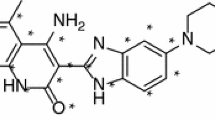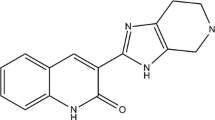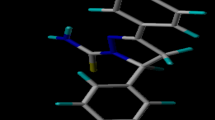Abstract
Vascular endothselial growth factor (VEGF) and its receptor tyrosine kinase VEGFR-2 or kinase insert domain receptor (KDR) have been identified as new promising targets for the design of novel anticancer agents. It is reported that 4-(1H-indazol-4-yl)phenylamino and aminopyrazolopyridine urea derivatives exhibit potent inhibitory activities toward KDR. To investigate how their chemical structures relate to the inhibitory activities and to identify the key structural elements that are required in the rational design of potential drug candidates of this class, molecular docking simulations and three-dimensional quantitative structure-activity relationship (3D-QSAR) methods were performed on 78 4-(1H-indazol-4-yl)phenylamino and aminopyrazolopyridine urea derivatives as KDR inhibitors. Surflex-dock was used to determine the probable binding conformations of all the compounds at the active site of KDR. As a result, multiple hydrophobic and hydrogen-bonding interactions were found to be two predominant factors that may be used to modulate the inhibitory activities. Comparative molecular field analysis (CoMFA) and comparative molecular similarity indices analysis (CoMSIA) 3D-QSAR models were developed based on the docking conformations. The CoMFA model produced statistically significant results with the cross-validated correlation coefficient q2 of 0.504 and the non-cross-validated correlation coefficient r2 of 0.913. The best CoMSIA model was obtained from the combination of steric, electrostatic and hydrophobic fields. Its q2 and r2 being 0.595 and 0.947, respectively, indicated that it had higher predictive ability than the CoMFA model. The predictive abilities of the two models were further validated by 14 test compounds, giving the predicted correction coefficients r 2pred of 0.727 for CoMFA and 0.624 for CoMSIA, respectively. In addition, the CoMFA and CoMSIA models were used to guide the design of a series of new inhibitors of this class with predicted excellent activities. Thus, these models may be used as an efficient tool to predict the inhibitory activities and to guide the future rational design of 4-(1H-indazol-4-yl)phenylamino and aminopyrazolopyridine urea derivatives-based novel KDR inhibitors with potent activities.

Molecular docking and three-dimensional quantitative structure-activity relationship (3D-QSAR) methods were applied to a set of 4-(1H-indazol-4-yl) phenylamino and aminopyrazolopyridine urea derivatives-based KDR inhibitors






Similar content being viewed by others
References
Risau W (1997) Mechanisms of angiogenesis. Nature 386:671–674
Ribatti D, Vacca A, Nico B, Roncali L, Dammacco F (2001) Postnatal vasculogenesis. Mech Dev 100:157–163
Folkman J (1971) Tumor angiogenesis: therapeutic implications. N Engl J Med 285:1182–1186
Hanahan D, Folkmann J (1996) Patterns and emerging mechanisms of the angiogenic switch during tumorigenesis. Cell 86:353–364
Liotta LA, Steeg PS, Stetler-Stevenson WG (1991) Cancer metastasis and angiogenesis: an imbalance of positive and negative regulation. Cell 64:327–336
Hicklin DJ, Ellis LM (2005) Role of the vascular endothelial growth factor pathway in tumor growth and angiogenesis. J Clin Oncol 23:1011–1027
Ferrara N (2004) Vascular endothelial growth factor: basic science and clinical progress. Endocr Rev 25:581–611
Baka S, Clamp AR, Jayson GC (2006) A review of the latest clinical compounds to inhibit VEGF in pathological angiogenesis. Expert Opin Ther Targets 10:867–876
Sepp-Lorenzino L, Thomas KA (2002) Antiangiogenic agents targeting vascular endothelial growth factor and its receptors in clinical development. Expert Opin Invest Drugs 11:1447–1465
Klebl BM, Müller G (2005) Second-generation kinase inhibitors. Expert Opin Ther Targets 9:975–993
Supuran CT, Scozzafava A (2004) Protein tyrosine kinase inhibitors as anticancer agents. Expert Opin Ther Pat 14:35–53
Holmes K, Roberts OL, Thomas AM, Cross MJ (2007) Vascular endothelial growth factor receptor-2: structure, function, intracellular signaling and therapeutic inhibition. Cell Signal 19:2003–2012
Sakamoto KM (2004) SU-11248 (SUGEN). Curr Opin Invest Drugs 5:1329–1339
Ahman T, Eisen T (2004) Kinase inhibition with BAY43-9006 in renal cell carcinoma. Clin Cancer Res 10:6388s–6392s
Dai YJ, Hartandi K, Ji ZQ, Ahmed AA, Albert DH, Bauch JL, Bouska JJ, Bousquet PF, Cunha GA, Glaser KB, Harris CM, Hickman D, Guo J, Li J, Marcotte PA, Marsh KC, Moskey MD, Martin RL, Olson AM, Osterling DJ, Pease LJ, Soni NB, Stewart KD, Stoll VS, Tapang P, Reuter DR, Davidsen SK, Michaelides MR (2007) Discovery of N-(4-(3-amino-1H-indazol-4-yl)phenyl)-N’- (2-fluoro-5-methylphenyl)urea (ABT-869), a 3-aminoindazole-based orally active multitargeted receptor tyrosine kinase inhibitor. J Med Chem 50:1584–1597
Dai YJ, Hartandi K, Soni NB, Pease LJ, Reuter DR, Olson AM, Osterling DJ, Doktor SZ, Albert DH, Bouska JJ, Glaser KB, Marcotte PA, Stewart KD, Davidsen SK, Michaelides MR (2008) Identification of aminopyrazolopyridine ureas as potent VEGFR/PDGFR multitargeted kinase inhibitors. Bioorg Med Chem Lett 18:386–390
Cramer RD 3rd, Patterson DE, Bunce JD (1988) Comparative molecular field analysis (CoMFA). 1. Effect of shape on binding of steroids to carrier proteins. J Am Chem Soc 110:5959–5967
Klebe G, Abraham U, Mietzner T (1994) Molecular similarity indices in a comparative analysis (CoMSIA) of drug molecules to correlate and predict their biological activity. J Med Chem 37:4130–4146
SYBYL 7.3 is available from Tripos Associates Inc, 1699 S Hanley Rd, St Louis, MO 631444, USA
Jain AN (2003) Surflex: fully automatic flexible molecular docking using a molecular similarity-based search engine. J Med Chem 46:499–511
Jain AN (2007) Surflex-Dock 2.1: robust performance from ligand energetic modeling, ring flexibility, and knowledge-based search. J Comput Aided Mol Des 21:281–306
Pan J, Liu GY, Cheng J, Chen XJ, Ju XL (2010) CoMFA and molecular docking studies of benzoxazoles and benzothiazoles as CYP450 1A1 inhibitors. Eur J Med Chem 45:967–972
Sun JY, Cai SX, Yan N, Mei H (2010) Docking and 3D-QSAR studies of influenza neuraminidase inhibitors using three-dimensional holographic vector of atomic interaction field analysis. Eur J Med Chem 45:1008–1014
Author information
Authors and Affiliations
Corresponding authors
Rights and permissions
About this article
Cite this article
Wu, X., Wu, S. & Chen, WH. Molecular docking and 3D-QSAR study on 4-(1H-indazol-4-yl) phenylamino and aminopyrazolopyridine urea derivatives as kinase insert domain receptor (KDR) inhibitors. J Mol Model 18, 1207–1218 (2012). https://doi.org/10.1007/s00894-011-1146-9
Received:
Accepted:
Published:
Issue Date:
DOI: https://doi.org/10.1007/s00894-011-1146-9




